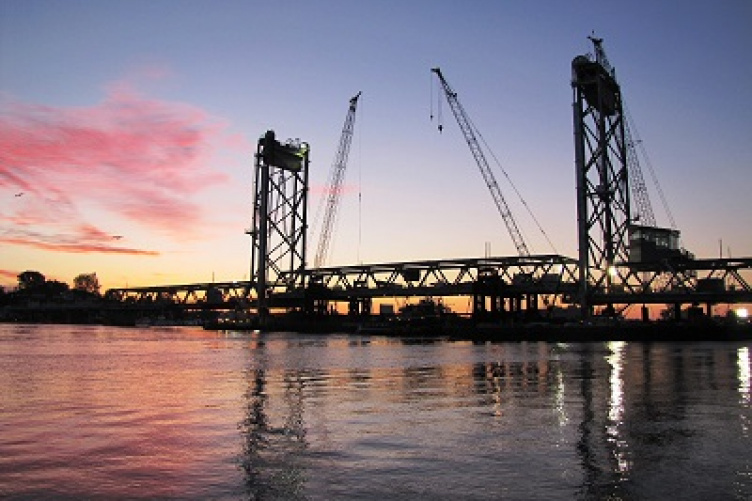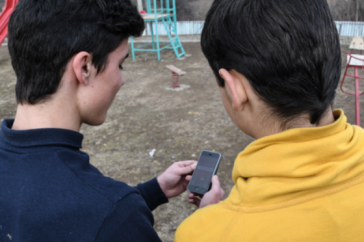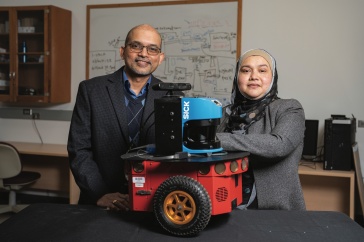
A new project led by UNH engineers will transform the Memorial Bridge over the Piscataqua River into a “living” bridge that could change the way we look at bridges and infrastructure in the near future.
The Living Bridge Project, a collaborative effort led by UNH with funding from the National Science Foundation’s Partnerships for Innovation program and the New Hampshire Department of Transportation, will install sensors on the bridge to provide infrastructure engineers and community members with a wide range of data, from the status of the bridge’s health, to traffic, weather, sea level, and tidal information.
“We anticipate transforming this landmark into a bridge that can sense its environment, talk to us, and, ultimately, ‘feed’ itself with renewable tidal energy,” says Erin Bell, UNH associate professor of civil engineering and principal investigator of the Living Bridge Project. “This bridge can do so much more than just get you across the river. I can see myself and colleagues learning from this bridge for 20 years, and I can also see people from the Portsmouth/Kittery area getting excited about what the bridge has to offer.”
Bell and colleagues will demonstrate some of the Living Bridge’s potential during the second annual Memorial Bridge 5K Road Race and Prescott Park’s Chili Cook-off Saturday, Oct. 11, 2014. The UNH team will attach temporary structural sensors to the bridge to capture the vibration from vehicular traffic and the runners. While the full project, with sensors powered by tidal energy via a tidal turbine beneath the bridge, will take up to three years to complete, community members can get a glimpse of the project on “Bridge Sundays” this fall, when UNH researchers will be at the bridge to introduce the project and attach temporary structural sensors to capture bridge behavior. Dates will be available at http://smartbuildings.unh.edu/?page_id=642.
Future projects on the vertical lift bridge might feature a lighting system, visible from afar, that communicates whether the tide is coming in or going out; instrumentation below the bridge that provides valuable data on fish species; or a public user interface that teaches engineering and physics concepts by tracking the load on the lift span as it raises and lowers to let boat traffic pass beneath. A camera atop the bridge could monitor upcoming construction on the upriver Sarah Mildred Long Bridge and even share photos via social media. Outreach efforts will make bridge data, history, and information about new systems accessible and understandable to the public and K-12 educators. Public awareness will be assessed with survey methods used in the N.H. Granite State Poll.
"We’re only limited by imagination. Our idea is to tie in transportation, biology, ocean science, and engineering,” says collaborator Ken Baldwin, UNH professor of ocean engineering. “We want to create a smart system that will provide information to the boating community, the general public, and those who are driving on the bridge as well as to civil engineers monitoring the health of the bridge.”
In addition to Bell and Baldwin, UNH collaborators are Tat Fu, assistant professor of civil engineering; Martin Wosnik, associate professor of mechanical engineering; and Lawrence Hamilton, professor of sociology, and Kalle Matso, director of the UNH Center for Collaborative Science, who will assess public engagement with the bridge.
Primary industrial partners are a large business, MacArtney Underwater Technology Group, Inc. (Houston, Tex.) and a small business, Lite Enterprises, Inc. (Nashua, N.H.). Broader context partners are New Hampshire Department of Transportation, NH Fish & Game, NH Port Authority, NH Coastal Program, City of Portsmouth, Sustainable Portsmouth, Maine Department of Transportation, U.S. Coast Guard, Archer/Western (Canton, Mass.), Parsons-Brinkerhoff (Manchester, N.H.), UNH Tech Camp, UNH Infrastructure and Climate Network, UNH Leitzel Center for Mathematics, Science and Engineering Education, and Massachusetts Institute of Technology's Changing Places (a joint Architecture and Media Laboratory Consortium, in Cambridge, Mass.).
-
Written By:
Beth Potier | UNH Marketing | beth.potier@unh.edu | 2-1566


















































